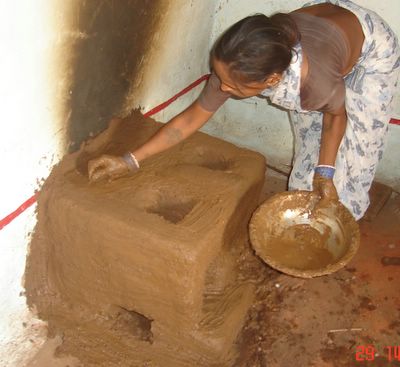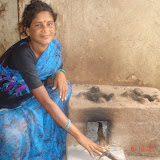Tuesday, June 05, 2007
Friday, June 01, 2007
Monday, May 01, 2006
GOOD STOVE
I have designed this stove, considering some of the basic principles of Larry Winiarsky. This stove is named as "Good Stove" a comment made by the first user. These stoves are constructed using easily available local raw material - bricks, clay, ash and cow-dung.
This is a multipurpose stove
1. Cooking is done with sticks.
2. There are twin fire places for cooking simultaneously (which people prefer).
3. Fire is intense and smoke is less.
There are two different size stoves constructed :
1. 5 inches x 5 inches openings model - for a family of 5 to 7 members - about 25 bricks are needed (total cost about Rupees 50 and one hour time for construction).
2. 6 inches x 6 inches openings model - for a family of about 10 members - about 30 bricks are needed. (total cost about Rupees 60 and one hour time for construction).
People are happy with these models as they are more efficient, less smokey, consume less wood and easy to construct and repair with local material.
275 Households (covering more than 70% of households) in Srirangapur Village, Kondurg Mandal and Kothur Village, Midjil Mandal in Mahabubnagar District, Andhra Pradesh State have adopted these stoves till date under the Project "Vulnerability Assessment and Enhancing Adaptive Capacity to Climate Change in semi-arid areas in India", supported by Swiss Agency for Development and Cooperation (SDC) and implmented by AFPRO www.afpro.org
Two jumbo Good Stove's was constructed for cooking mid-day meals at the Two Government Schools in Srirangapur and Kothur villages, where everyday 50 children are served meals.
This is a multipurpose stove
1. Cooking is done with sticks.
2. There are twin fire places for cooking simultaneously (which people prefer).
3. Fire is intense and smoke is less.
There are two different size stoves constructed :
1. 5 inches x 5 inches openings model - for a family of 5 to 7 members - about 25 bricks are needed (total cost about Rupees 50 and one hour time for construction).
2. 6 inches x 6 inches openings model - for a family of about 10 members - about 30 bricks are needed. (total cost about Rupees 60 and one hour time for construction).
People are happy with these models as they are more efficient, less smokey, consume less wood and easy to construct and repair with local material.
275 Households (covering more than 70% of households) in Srirangapur Village, Kondurg Mandal and Kothur Village, Midjil Mandal in Mahabubnagar District, Andhra Pradesh State have adopted these stoves till date under the Project "Vulnerability Assessment and Enhancing Adaptive Capacity to Climate Change in semi-arid areas in India", supported by Swiss Agency for Development and Cooperation (SDC) and implmented by AFPRO www.afpro.org
Two jumbo Good Stove's was constructed for cooking mid-day meals at the Two Government Schools in Srirangapur and Kothur villages, where everyday 50 children are served meals.
Principle:
The extra chimney effect is cause by the second pot, the total length travelled by the left over combustable gases is greater due to second pot, there is greater chance that all the gases are combusted in the two pot stove.
Pre-heating of air happens at the primary air hole area as the stoves starts burning, the embers from the carcoal pieces lie at the bottom. The primary air entering underneath the wood gets heated due to the presence of these embers upto the entrance. The preheated air is good for better combustion.
Regular pasting the stove, especially in the combustion area with the clay mixed with ash, cowdung and sand is very much useful for higher efficiency performance of the stove.
The smooth pasting improves the aerodynamic property of the combustion area and improves the flow of the flames reaching the pots with very losses of energy.
Subscribe to:
Posts (Atom)




















